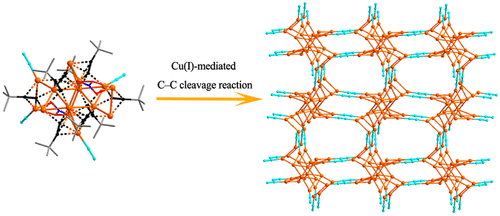当前位置:
X-MOL 学术
›
Cryst. Growth Des.
›
论文详情
Our official English website, www.x-mol.net, welcomes your
feedback! (Note: you will need to create a separate account there.)
Assembly of Cu(I) Alkynyl Complexes: From Cluster to Infinite Cluster-Based Framework
Crystal Growth & Design ( IF 3.2 ) Pub Date : 2019-08-28 , DOI: 10.1021/acs.cgd.9b00803
Yun-Peng Xie 1 , Jun-Bo Wen 1 , Chang-Wang Pan 1 , Guang-Xiong Duan 1 , Lan-Yun Li 1 , Xing Lu 1
Crystal Growth & Design ( IF 3.2 ) Pub Date : 2019-08-28 , DOI: 10.1021/acs.cgd.9b00803
Yun-Peng Xie 1 , Jun-Bo Wen 1 , Chang-Wang Pan 1 , Guang-Xiong Duan 1 , Lan-Yun Li 1 , Xing Lu 1
Affiliation

|
Variation of the reaction conditions with Cu powder, Cu(NO3)2, and tBuC≡CH as starting materials afforded three new Cu(I) alkynyl complexes, namely, [Cu14(tBuC≡C)10(NO3)4(MeOH)2]·H2O (1), Cu15(tBuC≡C)14(NO3) (2), and [Cu14(tBuC≡C)8(NO3)2(CN)4]n (3). Single-crystal X-ray analysis revealed that clusters 1 and 2 consist of Cu14 and Cu15 cores costabilized by strong by σ- and π-bonded tert-butylethynides and nitrates. Complex 3 displays an intriguing three-dimensional cyano-bridged Cu(I) alkynyl cluster-based framework, in which the existence of CN– is assumed to have originated from the Cu(I)-mediated C–C cleavage reaction of acetonitrile under mild solvothermal conditions.
中文翻译:

铜(I)炔基配合物的组装:从群集到基于无限群集的框架。
与Cu粉末,铜(NO反应条件的变化3)2,和吨BuC≡CH作为原料得到了三个新的Cu(I)配合物的炔基,即,[铜14(吨BuC≡C)10(NO 3)4(甲醇)2 ]·H 2 O(1),铜15(吨BuC≡C)14(NO 3)(2)和[铜14(吨BuC≡C)8(NO 3)2(CN)4 ] n(3)。X射线单晶分析表明,簇1和簇2由Cu 14和Cu 15核组成,并通过σ和π键结合的叔丁基乙炔和硝酸盐的增强而稳定化。复杂3只显示一个有趣的三维氰桥的Cu(I)炔基基于群集的框架,在该CN的存在-假定为源自下温和乙腈的Cu(I)介导的C-C切割反应溶剂热条件。
更新日期:2019-08-29
中文翻译:

铜(I)炔基配合物的组装:从群集到基于无限群集的框架。
与Cu粉末,铜(NO反应条件的变化3)2,和吨BuC≡CH作为原料得到了三个新的Cu(I)配合物的炔基,即,[铜14(吨BuC≡C)10(NO 3)4(甲醇)2 ]·H 2 O(1),铜15(吨BuC≡C)14(NO 3)(2)和[铜14(吨BuC≡C)8(NO 3)2(CN)4 ] n(3)。X射线单晶分析表明,簇1和簇2由Cu 14和Cu 15核组成,并通过σ和π键结合的叔丁基乙炔和硝酸盐的增强而稳定化。复杂3只显示一个有趣的三维氰桥的Cu(I)炔基基于群集的框架,在该CN的存在-假定为源自下温和乙腈的Cu(I)介导的C-C切割反应溶剂热条件。































 京公网安备 11010802027423号
京公网安备 11010802027423号